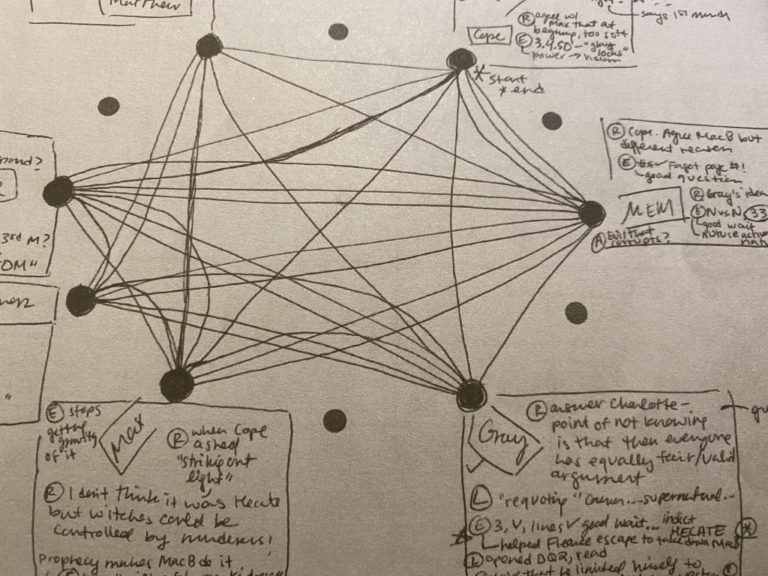The 3 Purposes of Class Discussion in an AI World
As we head back to school, questions and concerns regarding AI’s role in students’ lives resurface. In an AI world, what do students actually need to learn? How should they communicate? Is class discussion still relevant?
Our short answer: yes! Especially in a world dominated by machines that serve individual needs, discussion skills are a critical force for social good. Students can — and must! — learn these skills, and recognize their power, in school.
What follows is an excerpt from our whitepaper on the future of discussion skills in an AI world. As you head back to school this fall, we hope you’ll keep in mind these three purposes of class discussion — and remember that these skills can (and must) be taught.
The genesis of AI may have tweaked the rules of class discussion, but it hasn’t changed the game itself. Class discussion becomes about more than checking whether students have done the reading. It becomes about teaching the art of live communication and
ultimately preparing kids to connect with other humans within and beyond school. When AI is a given, class discussion becomes about communication skills, not content: it’s about process and reflection, not checking a box. In an AI world, there are three clear
purposes of class discussion.
Purpose #1: Class Discussion Can Teach Students Communication Skills and Intellectual Resilience
Teachers, researchers, and kids themselves have made it clear: for today’s students, in-person conversation is difficult, stressful, and even frightening. In-person conversations require a certain release of control, thanks to the real, live people who share unexpected thoughts, tell unexpected jokes, make unexpected gaffes, and pull unexpected facial expressions. Preparing for and reacting appropriately to the many layers of in-person conversation, then, is challenging — much more challenging, of course, than conversing with a chatbot using prompts teens themselves choose.
Today’s students know an important truth: AI will not wince, yell, cry, block, or cancel them based on what they say. Chatbots, thus, are perhaps a more comfortable conversation partner — but they don’t do the hard work of preparing students for the intimacy and art of conversations that define real life.
Today’s students know an important truth: AI will not wince, yell, cry, block, or cancel them based on what they say. Chatbots, thus, are perhaps a more comfortable conversation partner — but they don’t do the hard work of preparing students for the intimacy and art of conversations that define real life.
Interestingly, though, there is value in doing the hard work of learning how to communicate in person because it is hard — and because the payoff of the challenge is not just a workplace skill but the emotional satisfaction of human connection. As
educator Eric Hudson writes in his Substack Learning on Purpose, “If we look at Lev Vygotsky’s Zone of Proximal Development or Mihaly Csikszentmihalyi’s concept of Flow, students learn when they take on challenging tasks that are emotionally satisfying and involve the guidance of a skilled partner like a teacher, tutor, or peer. Designing learning experiences for challenge is different than simply making things hard.”’
Class discussion can be such an experience, thoughtfully designed to challenge students in a safe space, guided and prompted by a trained practitioner. The result, for students, can be overwhelmingly positive. Hudson explains: “Camille Farrington’s research (among many other examples) shows belonging, relevance, and confidence in success all contribute to deeper learning because they are factors in 1) the student’s trust in the teacher and in the value of the task and 2) their motivation to try something new or hard.”
Trust is the operative word here. Done well, class discussion is an exercise in trust-building: students trust the teacher to assess them fairly, to intervene appropriately, and to provide feedback they need to grow. Students learn to trust each other to listen, to show up authentically, to ask questions, and to build something together that none of them could by themselves.
Done well, class discussion is an exercise in trust-building: students trust the teacher to assess them fairly, to intervene appropriately, and to provide feedback they need to grow. Students learn to trust each other to listen, to show up authentically, to ask questions, and to build something together that none of them could by themselves.
Purpose #2: Class Discussion Shows Students the Power of Off-Screen Connection in a Screen-Bound World
Although experts debate exactly which social skills can be developed through a screen, it is clear that in-person, screen-free time is essential for wellbeing. Screen-free interactions build both the self-awareness and awareness of others that kids need to truly connect with each other.
There’s simple biology at play here. As a 2013 Scientific American article reported: “[a]cross many studies of mammals, from the smallest rodents all the way to us humans, the data suggests that we suffer greatly when our social bonds are threatened or severed…We may not like the fact that we are wired such that our well-being depends on our connections with others, but the facts are the facts.”
The human need to connect is, thus, not something people can choose to turn on or off. It’s a fundamental, foundational part of our humanity. The Social Baseline Theory (SBT), first discussed by psychologists James Coan and David Sbarra, posits that the human brain treats social connection as a resource, which, like food, water, and shelter, promotes safety. To put it bluntly: humans need to connect — physically and emotionally — in order to survive.
The human need to connect is, thus, not something people can choose to turn on or off. It’s a fundamental, foundational part of our humanity.
K-12 school is an excellent crucible for these very positive relationships. As technology becomes more omnipresent, these places and the adults who lead them become even more critical in helping children develop skills that aren’t just helpful for their education and careers — they’re essential for their future well-being.
“The skills that you need to live a healthy life right now I just think are very different than they were even 15 or 20 years ago,” says NAIS President Debra Wilson on a summer 2023 episode of the New View EDU podcast. “You look at the number of people who are in hybrid work things, or they’re always teleworking. We know that human connection is actually really important for people. It’s hard to do that if you’re working at your computer on a desk in your house 8-12 hours a day. And frankly, it’s not great for
communities if we lose these connections with each other.”
School, then, increasingly needs to become the place that prepares children for real life — and to succeed and connect in real life, even as technology erects more and more barriers to connection. “Everyone is concerned that AI is the education Armageddon,”
says Wilson. “I actually don’t think it is. I think it allows teachers to double-down on the relationships piece and to really demonstrate the kind of outcomes that we’re looking for in terms of people.”
Peter Nilsson, former Head of School at King’s Academy and current editor of The Educator’s Notebook, foresees a similar shift in the role and purpose of in-class education. “Class time is for social and relational learning, for personal and collective
meaning-making,” he says. Let chatbots help, guide, and quiz students at home – school is now for something more important, more foundational, and — yes — more human.
To make class discussion a true exercise in social and relational learning, it needs to be interactive, collective, and personal. It’s not enough for students to sit on their computers, taking notes in a Google doc while their classmates speak. When this happens, it indicates that children think the overarching purpose of discussion is the content of the conversation, not the actual act of discussing. Rather, teachers
need to emphasize the importance of uniquely human discussion skills – and they need to be endowed with the tools necessary to teach these discussion skills to their students.
To make class discussion a true exercise in social and relational learning, it needs to be interactive, collective, and personal.
Purpose #3: Class Discussion Cultivates Interdependence – and Ultimately Teaches Kids That They ‘Matter’
Class discussion teaches kids the skills they need to connect, which is essential for their health and the health of their broader communities. Class discussion does something more personal, too: it teaches kids that they matter.
Interdependence — the experience of mattering to each other — is a prerequisite for healthy relationships. An over-emphasis on individual achievement — the only kind of achievement that can be gleaned from interacting solely with AI — can undermine
relationships and create pressure to achieve alone.
In her book Never Enough: When Achievement Culture Becomes Toxic and What We Can Do About It, Jennifer Breheny Wallace connects the idea of interdependence to the psychological concept of mattering. She footnotes psychologists Morris Rosenberg and Adam Flett in studying the correlation behind mattering and high self-esteem in adolescents and articulates seven ingredients to feeling like you matter: Attention (feeling that you are noticed by others), Importance (feeling like you are significant), Dependence (feeling like you are important because others rely on you), Ego Extension (recognizing that others are emotionally invested in you and care what happen to you), Noted absence (feeling like you are missed if you aren’t there), Appreciation (feeling like
you and your actions were valued), Individuation (being made to feel unique, special, and known for your true self) (Wallace: 53-54).
AI cannot spark these seven components. Chatbots can do little more than tell students they matter — if, that is, they receive prompts that ask them to do so. Beyond making students feel good — a valuable and valid goal in and of itself — the mattering mindset
fosters success well beyond class discussion. Matthew Barzun, former US Ambassador, Tech Entrepreneur, and Media Leader, argues in The Power of Giving Away Power that interdependence has been an unconventional and winning leadership strategy in politics, business, medicine, law, religious leadership, and community life for over a century. He argues that great leadership comes from giving away power — essentially, from showing others they matter and cultivating independence on any team you lead.
One framework Barzun surfaces comes from Mary Parker Follett, an early 20th century business guru who coached business leaders to adopt the following norms for every
discussion (Barzun, 62):
- Expect to need others: you are making something together that you couldn’t do alone.
- Expect to be needed: you are there for a reason, so show up with your whole self.
- Expect to be changed: expect to leave the meeting not quite the same person as when you entered.
Barzun makes a compelling case for how these principles unlock innovative business thinking. As educators, though, we see how clearly they reinforce the necessity of mattering, independence, and class discussion. Learning how to share and receive ideas in real life, in real-time, helps children understand their power and truth. That creates foundational confidence that lasts in school, in their careers, in their personal relationships, and in their communities.
Learn more about how to teach students critical in-person conversation skills by reading our whitepaper or reaching out to our team.






